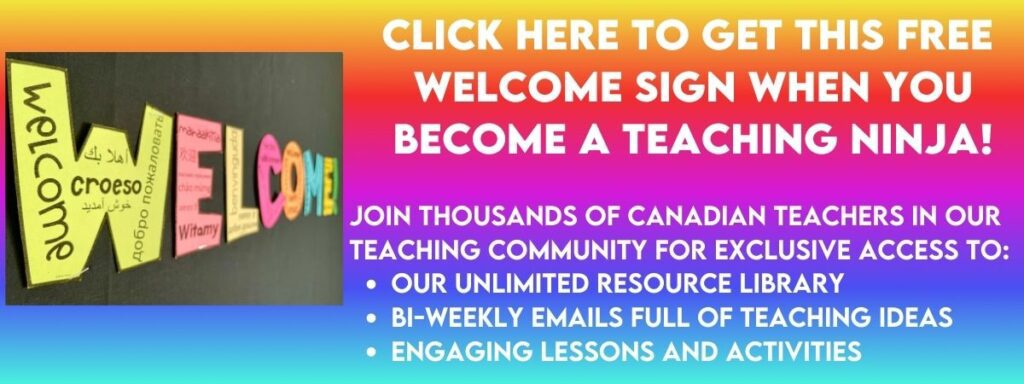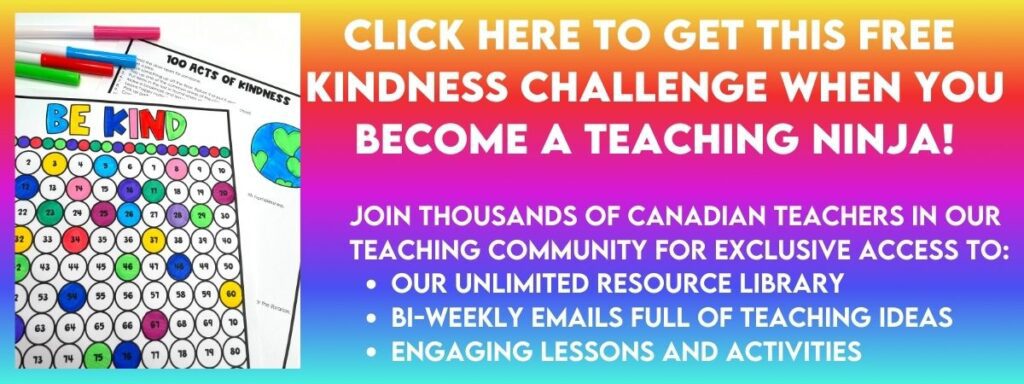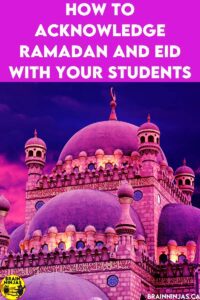
In our classroom, we celebrate everything. This year we learned about Ramadan with some of our Muslim students and celebrated Eid with a few different activities.
We think it’s important for all of our students to feel included. It doesn’t matter which different celebrations, observances or holidays they observe. Students share their customs and traditions with us. We celebrated Lunar New Year, Ukrainian Christmas, World Hijab Day, Halloween, Thanksgiving, and Christmas, and now we’re getting ready for Ramadan and Eid.
We speak eleven languages in our classroom this year. Out of twenty-nine students, eight were born outside of Canada (three in the United States, two in Syria, one in Palestine, one in Turkey and one in Russia). We have a greeting on our door in English, French, Spanish, Urdu, Arabic, Russian, Tagalog, Filipino, Portuguese, Ukrainian, and Mandarin. We are Christians, Muslims, Hindus and Buddhists, but we are all in the same class in the same school. This means we are a family.
You can get a copy of our Welcome Message for your own classroom. Find it in our Resource Library, or we can email it to you directly.
Decorating for Ramadan and Eid
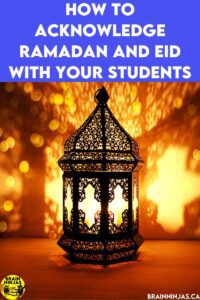
During Ramadan, we hang decorations after we make them.
Students brought in lightweight cardboard from cereal boxes. We cut the cardboard into large stars and crescent moons. We used metallic tempera paint to paint the stars and moons. For coloured cardboard, it took a few coats. Some of the students used glitter glue or glitter paint to add some sparkle to their pieces. We even experimented by covering the cardboard with tin foil. We got mixed results with white glue. Let it dry for twenty-four hours.
Using a one-hole punch, we punched a hole into each star or moon. We used a string to tie the stars and moons in a garland. We strung white lights across the front of our classroom and hung the garland on the string of lights.
Students made even more stars and moons and tied them to clothes hangers. Some students combined their projects together, creating a mobile. We hung it in the centre of the room. We hung others from anything we could find (the curtain rods, the random nails in the walls etc.)
Some of the students made paper lanterns, and we used battery-powered candles to light them up. We used patterns that are also used for Chinese New Year paper lanterns.
One of the families lent us a few actual battery-operated lanterns, which we used as well.
Learning About Ramadan and Eid
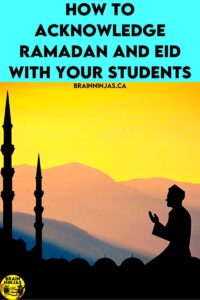
Part of the challenge of celebrating different holidays and observances is making sure students understand why different people celebrate different things. No students are forced to take part in anything or change their beliefs. This is strictly about allowing students to talk about what they celebrate in our classroom and school.
Before teaching in a larger city, our experiences with a variety of cultures were only from books. But, now, we’ve met many different people with backgrounds. This has meant we’ve had the opportunity to learn about many different people.
The one thing we all have in common is wanting to be included. That is why it is so important for us to teach our students that by learning about different cultures, we have nothing to fear from each other.
Ramadan is a sacred month observed by Muslims (people who practise the Islam religion). During this time, Muslims pray, abstain from pleasures and fast. Fasting takes place during the sunlight hours. This means families often eat early in the morning (a meal called suhur) or late at night (a meal that breaks the daily fast called iftar). Students sometimes experience less sleep when Ramadan lands during the summer months when there are more hours of sunlight.
We have written several short reading passages and created some simple writing activities in our Ramadan and Eid al-fitr Reading and Writing Activities. We created them to help our students get a basic amount of knowledge. It was difficult to find some of the information at a reading level our students could comprehend, so we just wrote our own. Find the Ramadan and Eid-al_fitr Reading and Writing Activities in our TPT Store ($USD) and BN Shop ($CAN).
Good Deeds Are Important
Muslims believe that good deeds help keep the spirit well. This is multiplied during Ramadan. We help our students perform acts of kindness. Find our kindness challenge in our Resource Library, or we can email it to you directly.
We have all our students write about kindness using this set of Kindness Writing Prompts. Find them in our TpT Store ($USD) or BN Shop ($CAN). Use them any time of year.
Include Your Community
We invite family members of our Muslim students to come to our class to share more information and allow our students to ask questions. When we have questions about whether or not our students are fasting or the girls should be wearing a hijab, we ask the family and the students to make sure we are respecting their wishes.
We collect books about Ramadan (you can see our list, Books for Ramadan) and shared our favourites with each other. Students are encouraged to talk about the different stories and compare them to each other. They read these books during silent reading, and sometimes, we share them as a whole class.
In the school, students made simple banners that read “Eid Mubarak.” Students decorated the banners and we hung them all over the school. Our students who returned after Eid were so happy to see them.
Another easy project is to create a collaborative poster that you can hang up in your classroom. Find our Eid Collaborative Poster in our TpT Store ($USD) or our BN Shop ($CAN).
How We Handle Different Traditions
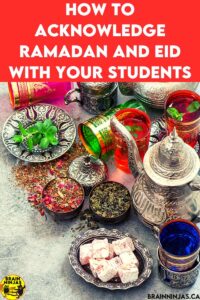
The feeling that we were all in the room celebrating together has made our Muslim friends feel welcome and included in all of our traditions.
Some students are fasting during this time, so we’ve also been careful to plan our social and celebratory events for after Ramadan.
And every year during Ramadan, a student will bring a treat for his or her birthday. We keep extra Ziploc bags just for this very reason. Any treats that are gifted to students during the day are packaged up and sent home with fasting students so they can enjoy their treats later in the evening when they can break their fast.
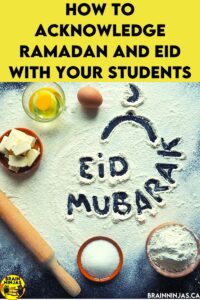
Students who stay at school during the lunch hour but are fasting are given a space to read, play board games or watch movies while other students in the school are eating.
Students who celebrate Eid often miss a day or two of school after the celebration, so we are careful not to plan any major assessments like tests during this time. We feel that all of our students, regardless of their faith, shouldn’t have to worry about school during their religious observances (just like we wouldn’t send home a project to be completed over Christmas break).
Looking for More Book Ideas for Other Holidays?
If you are looking for books or activities for some of the other holidays during the year, you should check out some of our other posts:
- Books for Lunar New Year
- Christmas Logic Puzzles and So Much More
- Christmas Books We Love
- Books for Remembrance Day
- Books for Lunar New Year
- Kindness Books
- Books for Orange Shirt Day
- Activities for Halloween.
Don’t forget you can find our Ramadan and Eid-al_fitr Reading and Writing Activities in our TPT Store ($USD) and BN Shop ($CAN), too. Eid Mubarak!
How do you acknowledge different faiths, languages and celebrations in your classroom? Is there a holiday you would like to see us write about? Be sure to share your ideas with us by commenting below.

